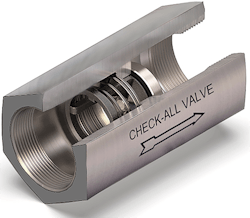Not All Check Valves Go With The Flow
Brian Strait, Business Development and Marketing Manager at Check-All Valve Mfg. Co.
Pardon the pun, but check valves are fairly straight forward -- they ensure flow in only one direction. In most designs, the upstream fluid force pushes a spring-loaded poppet open, allowing flow. An increase in downstream or back-pressure force drives the poppet back into the seat, stopping reverse flow. But their simplicity shouldn’t be taken for granted. Chemical Processing spoke with Brian Strait, Business Development and Marketing Manager at Check-All Valve Mfg. Co., and learned that not all check valves are created equally.Q: What is the difference between an engineered and a commodity check valve?
A: Well, a commodity check valve is a check valve that would be used in a broad-ranging area of applications and would likely be less expensive and handle less rigorous applications. For many applications that's perfectly acceptable. Whereas an engineered check valve might be built for more stringent application requirements that you'd be addressing.
For example, if you have vertical flow where the flow is downward in a piping system, a commodity check valve -- like a swing check valve -- wouldn't operate because the checking mechanism would hang open and thereby render it inoperable. With an engineered check valve, you could put the proper internal components in to allow the valve to operate in any flow orientation.
Q: What are some of the specific applications that can benefit from the engineered check valve?
A: There are several. I like to use a carwash analogy: At an automatic carwash several items from different fluid lines flow through the same nozzle -- water, soap, spot-free rinse, things like that. But that media will want to take the path of least resistance like flowing back through the other open fluid lines, rather than through that nozzle. So, to prevent this you need to put check valves in each different fluid line that are geared toward different pressures and flows. The spot-free rinse, for example, comes out real light and misty, whereas water comes out with high pressure, so you're going to have different settings with the different valves to make them work for those particular items.
Q: What about the specific attributes or features that are available in engineered valves? Is that something that's very case-by-case basis?
A: Somewhat. A lot of engineered products may not offer different variations. However, with our valves, we offer the widest range of spring settings, seat materials and body materials available to meet the most rigorous and specific applications. We only manufacture spring-loaded inline poppet check valves. This is all we do, which allows us to concentrate on providing check valves for practically every service application. We assemble our valves to order and stock a wide variety of components allowing us to ship most of our check valves within one week. We also manufacture custom valves for the most unique application requirements.
Q: Does somebody call you with the specifications? Do you go out and help them with that? How does that work?
A: We certainly get customers who will have concerns with their existing valve configurations and call us for advice. People don’t realize that the application challenges they encounter could be the result of a misapplied check valve. They may have breakdowns periodically and perform regular maintenance and exchange items out, not even realizing that there are check valves out there that can be configured to work in an application.
Check-All Valves are designed to meet specific requirements for any application.
Q: Do engineered valves require different maintenance or maintenance intervals than commodity check valve?
A: In my opinion, a properly configured engineered check valve won't require maintenance. It'll last in that application for years, if not decades of service. Whereas some commodity type of valves may have replacement parts. Swing checks are a real good example. They've got a flapper that swings on a pin and the pin wears out over time because it may not open and close fully. It may bounce around or flutter in the application wearing the pin out, which for some people that's perfectly fine to go replace that periodically. For others, it can be a real issue if their system shuts down because their check valve isn’t working.
Q: Is there anything else to consider with check valves?
A: Well, one I can think of right off the top of my head is water hammer. Most people recognize water hammer as a noise in a piping system. It'll be a bang -- literally a bang in the system. You might experience that when you shut off the faucet at home too quickly and it makes a big bang. Well, in process systems, it can be a lot worse. For example, extreme water hammer can move pumps off their moorings. It’s basically a hydraulic shock. It's when liquid or media suddenly stops or goes in reverse flow and it creates a hydraulic shock that reverberates down the system. And oftentimes people, unless they've experienced it ahead of time, don't know what's causing that. Oftentimes what causes this is a not having a check valve in the system or a check valve that doesn't close properly to the stop flow or prevent reverse flow before the hydraulic shock begins.
There are many check valves out there that don't. Our check valves close before reverse flow begins, virtually eliminating that issue of water hammer. These inline valves are engineered for silent operation. They close quickly and smoothly to eliminate water hammer and are designed to function equally well in either a vertical or horizontal position, with proper spring selection. Introduced turbulence on the seating surfaces just before the check valve closes ensures positive sealing by removing minute foreign particles suspended in the fluid. The seating surfaces are parallel to each other, thereby eliminating the excessive wear occurring in plug, cone and ball seats.
Q: Is there anything else you’d like to add?
A: When it comes to having systems that operate efficiently, you're going to want different flows that work a certain way. For example, if you're filling orange juice bottles, you want to have the proper flow every time that bottle comes by for consistency. Or if you're having washdown stations where you're spraying chemical on a floor to clean up and get rid of bacteria, you want to have the right amount of chemical applied during every single cycle of cleaning. You don't want to overdo it or underdo it.
So, having a check valve in those situations that can ensure that the proper flows and pressures are available can be really important in a lot of applications.
For more information, visit: https://www.checkall.com


